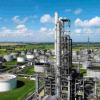|
|
Heat Transfer Issue
#1

Posted 29 April 2008 - 07:40 AM
I know the following for the material on each side of a wall:
specific heat
viscosity
thermal conductivity
density
velocity
for the wall in between them I know the following:
thickness
mean surface area
thermal conductivity
i understand all about Reynalds, Nusselts, and Prandtl number as well.
i also know the temperature that both substances will initially be.
i am trying to figure out how long in time it will take to get one substance (nylon in solid pellet form) to drop from 350 F to 100 F. this nylon will be in a tube with an auger inside moving at a slow rate to transport through the system. On the other side of the wall in the tube will be cold water around 40 F that will be circulating in order to draw the heat out of the nylon.
if I can figure out the temperature of either side of the wall, I can solve for how long my tube needs to be through lump mass approx method.
Here are some values I have if I attempt to solve for the wall temp assuming it is convective heat transfer:
For Nylon
Cp specific heat capacity 1670 J/kg-K
k thermal conductivity 0.25 W/m-K
v velocity 1.524 m/hr (rate of auger)
p density 560.645 kg/m^3
R resistance 102317.0565
u viscosity ?? it is around for 1E+12 kg/m-s for solids but this gives me a "h" that doesnt make sense when i solve for it using the Nusselt number.
so that didnt seem to work so instead i assume it is conductive heat transfer and use the following:
k thermal conductivity 0.25 W/m-K
x thickness 0.889 m
A Surface Area 17.01674016 m^2
R resistance 0.208970694
but again this does not make sense cause i end up getting a temperature on the S.S. wall of less than 41 F when it is next to 350 F, and the water temp on the other side of the wall is 40 F.
what gives?
and thanx.
#2

Posted 29 April 2008 - 08:21 AM
the task is quite simple, you need to write heat balance for: nylon (heat loss), water (heat gained) and for heat transferred:
Q_t = m_t*cp_t*(T_t1-T_t2)
Q_w = m_w*cp_w*(T_w1-T_w2)
Q = K*delta_T_log
of course Q = Q_t = Q_w
delta_T_log - I hope you know
heat transfer coefficient:
1/K = 1/(k_t*pi*R_out*L) + 1/(k_w*pi*R_in*L) + ln(R_our/R-in)/(pi*conductivity*L)
where k_t and k_w are heat transfer coefficients by convection and can be found from correlations (Nu)
solve for L (length of tube), you must assume some mass flow of water (m_w)
#3

Posted 29 April 2008 - 08:50 AM
i do not understand what your symbols equate to such as Q_t, m_t, k_t, delta_T_log, etc. can you please spell out what they are then i should be fine and thank you.
the task is quite simple, you need to write heat balance for: nylon (heat loss), water (heat gained) and for heat transferred:
Q_t = m_t*cp_t*(T_t1-T_t2)
Q_w = m_w*cp_w*(T_w1-T_w2)
Q = K*delta_T_log
of course Q = Q_t = Q_w
delta_T_log - I hope you know
heat transfer coefficient:
1/K = 1/(k_t*pi*R_out*L) + 1/(k_w*pi*R_in*L) + ln(R_our/R-in)/(pi*conductivity*L)
where k_t and k_w are heat transfer coefficients by convection and can be found from correlations (Nu)
solve for L (length of tube), you must assume some mass flow of water (m_w)
#4

Posted 30 April 2008 - 04:47 AM
viscosity is property of fluids (gases and liquids) only! it describes capability to flow!
in the case of solids one can say about friction (and not viscous interactions) - viscous interaction are sometimes called "internal friction"...
do not trust in all that you find in internet, it is not reliable and confirmed information database, especially wikipedia which is not verified properly
i do not understand what your symbols equate to such as Q_t, m_t, k_t, delta_T_log, etc. can you please spell out what they are then i should be fine and thank you.
Q - heat flux
m - mass flux
k - convective heat transfer coefficient
index "_w" refers to water and "_t" to nylon (sorry for this
#5

Posted 30 April 2008 - 08:51 AM
1. does R_out = radius?
2. can you please spell out what "ln(R_our/R-in)/(pi*conductivity*L)" means? (i only understand the "pi" and "L")
3. what is delta_T_log? ( i know what delta T means, but the "log" throws me off)
#6

Posted 30 April 2008 - 09:36 AM
R_in and R_out stand for inner and outer radius of the pipe, respectively
2. can you please spell out what "ln(R_our/R-in)/(pi*conductivity*L)" means? (i only understand the "pi" and "L")
this term stands for heat transfer through the pipe wall - it should be included in the total transfer coefficient (K), however it is neglected if thermal conductivity is high (e.g. copper) and is most important in the case of thermal insulation... for cylindircal geometry (pipe) the formula is as I wrote (it results from integration of Fourier equation)
3. what is delta_T_log? ( i know what delta T means, but the "log" throws me off)
http://en.wikipedia....ture_difference
#7

Posted 01 May 2008 - 06:24 AM
here is my data presented in two columns: i am solving for T1 under water, and know it should be greater than that! my nylon will be flowing at a rate of 1200 lb/hr.
Inside Shell Area
A1(from outside radius) 17.39144909 m^2
A2(from inside radius) 17.01674016 m^2
Nylon Production Rate
1200 lb/hr
544.311 kg/hr
Q(water)=Q(nylon)=Q(system)
Q=mass flux*Cp*delta T
Nylon
mass flux 1.879725255 kg/hr
Cp 1670 J/kg-K
T0 350 F
T1 100 F
delta T 250 F
Q 784785.2938 J/hr
Q 217.9959149 W
Water
mass flux 92.13637514 kg/hr
Cp 4186 J/kg-K
T0 50 F
T1 50.00056522 F
delta T 0.000565221 F
Q 784785.2938 J/hr
Q 217.9959149 W
Water Flow
1 gallon water = 3.7854 kg
1 GPM
3.7854118 kg/min
92.13637514 kg/hr*m^2
#8

Posted 01 May 2008 - 08:08 AM
m_n 544.311 kg/hr
Cp 1670 J/kg-K
T0 350 F
T1 100 F
Water
m_w 3.7854118 kg/min
Cp 4186 J/kg-K
T0 50 F
for above values (I do not know if correct, but you provided this) the calculated temp. of water on outlet about 142.8 C (about 289 F)...
#9

Posted 01 May 2008 - 08:44 AM
R_in = 0.4m
R_out = 0.405m
thermal conductivity of pipe material = 45W/m*K (as for stainless steel)
k_n = 100W/m^2*K (assumed for calculation only, not calculated from Nu)
k_w = 100W/m^2*K (assumed for calculation only, not calculated from Nu)
then:
L = 14.8m
give your real values and I can calculate this for you
P.S. maybe in your calculation you did not correctly (or at all) convert units...?
#10

Posted 01 May 2008 - 08:48 AM
#11

Posted 01 May 2008 - 02:58 PM
the thermal conductivity of the stainless steel is 17 W/m-K not 45. 45 is the value for normal steel.
but to be honest I do not see where that value is playing a part in the answer to solve this problem other than calculating the heat transfer coefficient for nylon?
these are the values i used in this problem:
Inside Shell
surface area = (A1-A2)/ln(A1/A2)
l1 240 in 6.096 m
r1(inside) 18 in 0.4572 m
A1(inside) 17.39144909 m^2
l2 240 in 6.096 m
r2(outside) 17.5 in 0.4445 m
A2(outside) 17.01674016 m^2
Mean Area 17.2034145 m^2
thermal conductivity
water->0.58 W/m-K
nylon->0.25 W/m-K
heat transfer coefficient
nylon->12.44649354 W/m^2-K
solved water heat transfer coefficient by the following:
Cp specific heat capacity 4186 J/kg-K
u viscosity 0.001 kg/m-s
k thermal conductivity 0.58 W/m-K
v velocity 182 m/hr
p density 999.97 kg/m^3
R resistance 9.30495E-06
Pr = Prandtl Cp*u/k
Pr Prandtl 7.217241379
Re = Reynalds (V/A)*v*p/u
Re Reynalds 293946.4796
Nu = .023*Re^.8*Pr^.4
Nu Nusselt 17.20806848
Nu Nusselt h*(V/A)/k(fluid)
h heat transfer coefficient Nu*(A/V)*k(fluid)
h heat transfer coefficient 6179.455582 W/m^2-K
solved water heat transfer coefficient by the following:
thank you so much for your help!!
#12

Posted 01 May 2008 - 03:09 PM
so if everything looks correct i should be good?
the question that remains that i am unsure about is below?
isnt mass flux = pounds/(time*area^2) if so then 544.311 kg/hr and 3.78 kg/min->226.8kg/hr cannot be correct can they?
what do i use for this value?
thanx again!!
#13

Posted 02 May 2008 - 02:15 AM
2. thermal conductivity for stainless steel I found to be between 20 and 45 [W/m*K] (what is "normal steel"?) - it plays a role in heat transfer phenomenon which is: convection --> conduction --> convection
3. what stands for (V/A) in Reynolds or Nusselt numbers? it should be characteristic linear dimension here... btw. hydraulic diameter = cross section area / wetted perimeter
4. first time in my life I can see something like log mean surface area difference (you wrote "surface area = (A1-A2)/ln(A1/A2)")
5. r_inside > r_outside ??!!
6. over 6000 W/m2*K seems to be too high value for covective heat transfer coefficient, however I did not check your calculations, units etc.
#14

Posted 02 May 2008 - 10:17 AM
thank you
2. thermal conductivity for stainless steel I found to be between 20 and 45 [W/m*K] (what is "normal steel"?) - it plays a role in heat transfer phenomenon which is: convection --> conduction --> convection
i will take your word for it, noticed on a chart on the internet(lol) that "steel" was around 25, and "stainless steel" was around 17. not a big issue, i will conduct research on this in a technical book.
3. what stands for (V/A) in Reynolds or Nusselt numbers? it should be characteristic linear dimension here... btw. hydraulic diameter = cross section area / wetted perimeter
you are correct, i made the needed changes.
4. first time in my life I can see something like log mean surface area difference (you wrote "surface area = (A1-A2)/ln(A1/A2)")
is there anything wrong here???
5. r_inside > r_outside ??!!
typo on my part.
6. over 6000 W/m2*K seems to be too high value for covective heat transfer coefficient, however I did not check your calculations, units etc.
i just realized that my velocity of the water was merely an assumption on my part, so I am looking for the correct equations to calculate this now. once the velocity changes, so will this value.
#15

Posted 02 May 2008 - 12:10 PM
- thermal conductivity for stainless steel 12-26, but in [Btu/(hr*F*ft))] (26 correstponds to what I assumed, i.e. 45 [W/m*K]
- for carbon steel 0.5%C 31 [Btu/(hr*F*ft))][/b]
- for carbon steel 1.5%C 21 [Btu/(hr*F*ft))][/b]
first time in my life I can see something like log mean surface area difference (you wrote "surface area = (A1-A2)/ln(A1/A2)")
is there anything wrong here???
this applies to temperature difference as I wrote abive (delta_T_log)
#16

Posted 02 May 2008 - 01:08 PM
Water Velocity in Jacket
v = .4085*Q/(ro^2-ri^2)
Q flow rate 10 GPM
ro diameter 39 in
ri diameter 36 in
v 0.018155556 ft/s
v 19.921728 m/hr
once this happens, now my reynolds number equates to laminar flow.
i found two different things for laminar flow. one is for "Thermally developing, hydrodynamically developed laminar flow," and the other "Simultaneously developing laminar flow." what is the difference?
but when i plug either into the equation that determines which option to select under either i get a value in the thousands when it is looking for a value closer to----> RePr*(D/L)<33.3
Similar Topics
Heat Loss Calculation From Cylindrical Tan;Started by Guest_rasprocess2026_* , Yesterday, 02:04 AM |
|

|
||
Best Practices For Handling 50% Hf – Equipment Failures IssueStarted by Guest_Jaydip_* , 19 Jun 2025 |
|

|
||
Steam Pressure In Heat ExchangerStarted by Guest_mvanrijnbach_* , 15 Apr 2025 |
|

|
||
Heat Exchanger Steam FlowStarted by Guest_aliebrahem17_* , 25 Nov 2024 |
|

|
||
Discussion - Predict Storage Tank Heat Transfer Precisely By Jimmy D KStarted by Guest_raj shekhar_* , 25 Mar 2025 |
|

|

 FB
FB






